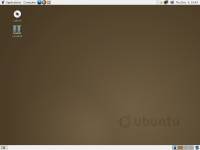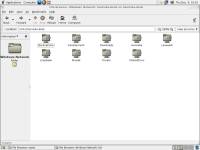index of articles :: take me home!
In
this article I will share my
experience with Linux (Ubuntu Linux)
with you. I
will use the LiveCD Warty version 4.10 as a basis for this
article. At the time of writing my Linux has been running for
17
days as can be seen below without a single problem crash problem.
warty@ubuntu:/var/log
$ uptime
07:24:50 up 17 days, 20:54, 1 user, load average: 0.48, 0.31, 0.22
For those that do not know, a LiveCD allows you to run Linux straight
from
your CD/DVD drive without installing Linux. It is a nice way
to
evaluate Linux without touching your existing Windows
installation. After you have played around in Linux, you can
just
take the CD out and reboot your machine and then you back into Windows.07:24:50 up 17 days, 20:54, 1 user, load average: 0.48, 0.31, 0.22
About Ubuntu Linux
Ubuntu Linux is the product of a
company called Canonical that is owned by Mark Shuttleworth.
Although it is funded and to a certain extend controlled by a company,
it is a community product and community involvement is a core
principle, hence the Ubuntu theme and name.
Ubuntu Linux has its origins in Debian Linux and follows the Debian development closely. It has the GNOME desktop environment as its default and follows the GNOME release cycle of 6 months as its release cycle. This is the main deference with Debian. Ubuntu will release a stable release every 6 months and the stable release will be supported with security fixes for a period of 18 months. The current stable release is Warty with a version number of 4.10. You might think that it is a strange number but it makes sense. It denotes the year and month of release namely October 2004. Development of the next release has already started, which is called Hoary Hedgehog. If you have an installed Warty and you are brave, then you can upgrade to Hoary and live on the edge. This can be done over the Internet by using a couple of commands or using the GUI tool called Synaptic. This is all for a next article.
Ubuntu Linux has its origins in Debian Linux and follows the Debian development closely. It has the GNOME desktop environment as its default and follows the GNOME release cycle of 6 months as its release cycle. This is the main deference with Debian. Ubuntu will release a stable release every 6 months and the stable release will be supported with security fixes for a period of 18 months. The current stable release is Warty with a version number of 4.10. You might think that it is a strange number but it makes sense. It denotes the year and month of release namely October 2004. Development of the next release has already started, which is called Hoary Hedgehog. If you have an installed Warty and you are brave, then you can upgrade to Hoary and live on the edge. This can be done over the Internet by using a couple of commands or using the GUI tool called Synaptic. This is all for a next article.
My hardware setup
I
have
a Compaq Presario 1800 on which the battery and the hard disk packed up
so it has no hard drive and no battery. It has the following:
- DVD ROM
- 384MB RAM
- USB hub with 4 USB ports
- Wireless Logitech keyboard and Optical Mouse plugged into USB hub
- Onboard 10/100 Ethernet LAN plugged in LAN hub
Starting point
Firstly
you need to get a copy of the
Ubuntu LiveCD. You can either download a copy from the first [1]
link below
or in SA from the second link [2] below or go
to this page
and contact
me and I will get one to you if you are in and around Cape Town.
The file you need to download is warty-live-i386.iso
or warty-live-i386.iso.torrent
if you going to use Bittorrent. If
you decide to download the ISO file yourself then take note that it is
almost 700MB in size and if you do not have broadband then it will take
a while. I actually downloaded the file and it took almost 48
hours using Bittorrent over my ISDN connection. After you
download the file then you have burn the ISO image to CD.
Make
sure you using the option in you CD Burning software to burn an image
and do not use the option to burn a data CD since then your CD will not
be bootable.
[1] http://releases.ubuntu.com/warty/
[2] ftp://ftp.is.co.za/linux/distributions/ubuntu/cdimage/releases/4.10/release/
Next make sure that your PC/laptop can boot from your CD/DVD drive. This setting is made in your computer's BIOS.
[1] http://releases.ubuntu.com/warty/
[2] ftp://ftp.is.co.za/linux/distributions/ubuntu/cdimage/releases/4.10/release/
Next make sure that your PC/laptop can boot from your CD/DVD drive. This setting is made in your computer's BIOS.
What is under the hood
Looking around the menus you will find
everything you need. Warty came with the following packages:
- GIMP for all you graphics needs
- Mozilla Firefox for Internet browsing
- Evolution for your email needs. [I prefer Thunderbird -- easily installable from the 1000's of packages in the online repository if you have an installed version of Warty]
- XChat for your IRC chatting
- GAIM for Instant Messaging [I used it with MSN and Yahoo and believe it also works with ICQ]
- OpenOffice of all your Word Processing, Spreadsheet and Presentation needs
- Rhythmbox for you music collection [On the LiveCD it only plays Open Source codecs like OGG but you can install other codes to play your MP3's]
- Totem movie player for watching your DVD's
- A whole bunch of Games
- Then the normal accessories like Calculator, Image Viewer, Text Editor and all the other good things that comes with a standard Linux distribution.
Conclusion
For a first release I was very
impressed with the quality of this release and the fact that it worked
will all my hardware impressed me even more. From now on this
will definitely be my first choice Linux distribution.
If you want to follow what is going on in the Ubuntu world then there is a couple of mailing lists -- visit the first link below [3] to subscribe. You can also browse the archives of these lists to see if your question has been dealt with in the past. Another good place to visit is the Wiki (set of web pages that is maintained by the community) at the second link below [4].
[3] http://www.ubuntulinux.org/community/lists/
[4] http://www.ubuntulinux.org/wiki/
Alternatively if you are into IRC (Internet Relay Chat) then join the #ubuntu, #ubuntu-doc or #ubuntu-devel channels on irc.freenode.org. As a community product you will always find somebody to help you out or answer your questions.
If you do not want to try Linux but use Windows based Open Source products like FireFox and OpenOffice then you can do it from the Ubuntu LiveCD. When you put the Ubuntu LiveCD into your CD/DVD drive when your Windows is running, you will get a menu that will allow you to install Windows based Open Source programs. See Linux CDs is even good in a Windows world :).
If you want to follow what is going on in the Ubuntu world then there is a couple of mailing lists -- visit the first link below [3] to subscribe. You can also browse the archives of these lists to see if your question has been dealt with in the past. Another good place to visit is the Wiki (set of web pages that is maintained by the community) at the second link below [4].
[3] http://www.ubuntulinux.org/community/lists/
[4] http://www.ubuntulinux.org/wiki/
Alternatively if you are into IRC (Internet Relay Chat) then join the #ubuntu, #ubuntu-doc or #ubuntu-devel channels on irc.freenode.org. As a community product you will always find somebody to help you out or answer your questions.
If you do not want to try Linux but use Windows based Open Source products like FireFox and OpenOffice then you can do it from the Ubuntu LiveCD. When you put the Ubuntu LiveCD into your CD/DVD drive when your Windows is running, you will get a menu that will allow you to install Windows based Open Source programs. See Linux CDs is even good in a Windows world :).
About the author:
 Marius
Bock is the
owner of Henriska Technology, a small company
that specializes in consulting on the use of Open Source Software and
the Internet. He has over 20 years experience in the ICT industry and
worked at major companies in South Africa. He can be contacted on [marius
At henriska DOT co DOT za] Marius
Bock is the
owner of Henriska Technology, a small company
that specializes in consulting on the use of Open Source Software and
the Internet. He has over 20 years experience in the ICT industry and
worked at major companies in South Africa. He can be contacted on [marius
At henriska DOT co DOT za] |
back to top :: index of articles :: take me home!
Copyright (c) Henriska
Technology - Marius Bock
2004
Verbatim copying and redistribution of this entire page is permitted
provided this notice is preserved.
| Support
Open
Source Software - Created using Nvu powered by Mozilla |

